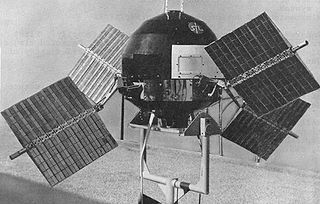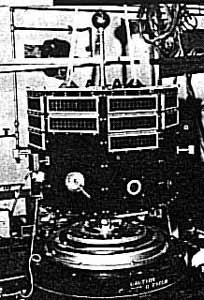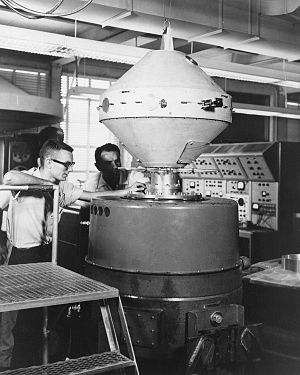Explorer 2 was an American unmanned space mission within the Explorer program. Intended to be a repetition of the previous Explorer 1 mission, which placed a satellite into medium Earth orbit, the spacecraft was unable to reach orbit due to a failure in the launch vehicle during launch.

Explorer 35,, was a spin-stabilized spacecraft built by NASA as part of the Explorer program. Designed for the study of the interplanetary plasma, magnetic field, energetic particles, and solar X-rays, from lunar orbit.

Explorer 6, or S-2, was a NASA satellite, launched on 7 August 1959, at 14:24:20 GMT. It was a small, spheroidal satellite designed to study trapped radiation of various energies, galactic cosmic rays, geomagnetism, radio propagation in the upper atmosphere, and the flux of micrometeorites. It also tested a scanning device designed for photographing the Earth's cloud cover. On 14 August 1959, Explorer 6 took the first photos of Earth from a satellite.

Explorer 7 was a NASA satellite launched on 13 October 1959, at 15:30:04 GMT, by a Juno II launch vehicle from Cape Canaveral Air Force Station (CCAFS) to an orbit of 573 × 1,073 km (356 × 667 mi) and inclination of 50.27°. It was designed to measure solar X-ray and Lyman-alpha flux, trapped energetic particles, and heavy primary cosmic rays. Secondary objectives included collecting data on micrometeoroid penetration, molecular sputtering and studying the Earth-atmosphere heat balance.

Explorer 32, also known as Atmosphere Explorer-B (AE-B), was a NASA satellite launched by the United States to study the Earth's upper atmosphere. It was launched from Cape Canaveral on a Delta C1 launch vehicle, on 25 May 1966. It was the second of five "Atmosphere Explorer", the first being Explorer 17. Though it was placed in a higher-than-expected orbit by a malfunctioning second stage on its launch vehicle, Explorer 32 returned data for ten months before failing due to a sudden depressurization. The satellite reentered the Earth's atmosphere on 22 February 1985.

Explorer 17 was a NASA satellite, launched at Cape Canaveral from LC-17B on a Delta B launch vehicle, on 3 April 1963, at 02:00:02 GMT, to study the Earth's upper atmosphere. It was the first satellite of five "Atmosphere Explorer".

Explorer 33, also known as IMP-D and AIMP-1, was a spacecraft in the Explorer program launched by NASA on 1 July 1966 on a mission of scientific exploration. It was the fourth satellite launched as part of the Interplanetary Monitoring Platform series, and the first of two "Anchored IMP" spacecraft to study the environment around Earth at lunar distances, aiding the Apollo program. It marked a departure in design from its predecessors, IMP-A through IMP-C. Explorer 35 was the companion spacecraft to Explorer 33 in the Anchored IMP program, but Explorer 34 (IMP-F) was the next spacecraft to fly, launching about two months before AIMP-E, both in 1967.

C/NOFS, or Communications/Navigation Outage Forecasting System was a USAF satellite developed by the Air Force Research Laboratory (AFRL) Space Vehicles Directorate to investigate and forecast scintillations in the Earth's ionosphere. It was launched by an Orbital Sciences Corporation Pegasus-XL launch vehicle at 17:02:48 UTC on 16 April 2008 and decayed on 28 November 2015.

Explorer 54, also called as AE-D, was a NASA scientific satellite belonging to series Atmosphere Explorer, being launched on 6 October 1975 from Vandenberg Air Force Base board a Thor-Delta 2910 launch vehicle.

The ISEE-1 was an Explorer-class mother spacecraft, International Sun-Earth Explorer-1, was part of the mother/daughter/heliocentric mission. ISEE-1 was a 340.2 kg (750 lb) space probe used to study magnetic fields near the Earth. ISEE-1 was a spin-stabilized spacecraft and based on the design of the prior IMP series of spacecraft. ISEE-1 and ISEE-2 were launched on 22 October 1977, and they re-entered on 26 September 1987.

Explorer 27 was a small NASA satellite, launched in 1965, designed to conduct scientific research in the ionosphere. It was powered by 4 solar panels. One goal of the mission was to study in detail the shape of the Earth by way of investigating variations in its gravitational field. It was the third and last of the Beacons in the Explorers program. The satellite was shut off in July 1973 so that its transmission band could be used by higher-priority spacecraft.

Explorer 20, also known Ionosphere Explorer-A, IE-A, S-48, TOPSI and Topside Explorer, was a NASA satellite launched as part of Explorer program. Its purpose was two-fold: long-term investigation of the ionosphere from above, and in situ investigation of ion concentrations and temperatures.

Explorer 22 was a small NASA ionospheric research satellite launched 9 October 1964, part of NASA's Explorer Program. It was instrumented with an electrostatic probe, four radio beacons for ionospheric research, a passive laser tracking reflector, and two radio beacons for Doppler navigation experiments. Its objective was to provide enhanced geodetic measurements of the Earth as well as data on the total electron content in the Earth's atmosphere and in the satellite's immediate vicinity.

Explorer 31, also called DME-A, was a NASA satellite launched as part of the Explorer program. Explorer 31 was launched on 29 November 1965 from Vandenberg Air Force Base, California, with a Thor-Agena launch vehicle. Explorer 31 was released along with the Canadian satellite Alouette 2.

Explorer 38 was the first NASA satellite to study Radio astronomy. Explorer 38 was launched as part of the Explorer program, being the first of the 2 RAE-satellites. Explorer 38 was launched on 4 July 1968 from Vandenberg Air Force Base, California, with a Delta J launch vehicle.

Explorer 40, was a NASA magnetically aligned satellite launched simultaneously with Explorer 39 (AD-C) using a Scout B launch vehicle.

Explorer 51, also called as AE-C, was a NASA scientific satellite belonging to series Atmosphere Explorer, being launched on 16 December 1973, at 06:18:00 UTC, from Vandenberg board a Delta 1900 launch vehicle.
Explorer 55, also called as AE-E, was a NASA scientific satellite belonging to series Atmosphere Explorer, being launched on 20 November 1975 from Cape Canaveral Air Force Station (CCAFS) board a Thor-Delta 2910 launch vehicle.

Dynamics Explorer 1 was a NASA high-altitude mission, launched on 3 August 1981, and terminated on 28 February 1991. It consisted of two satellites, DE-1 and DE-2, whose purpose was to investigate the interactions between plasmas in the magnetosphere and those in the ionosphere. The two satellites were launched together into polar coplanar orbits, which allowed them to simultaneously observe the upper and lower parts of the atmosphere.

Dynamics Explorer 2 was a NASA low-altitude mission, launched on 3 August 1981. It consisted of two satellites, DE-1 and DE-2, whose purpose was to investigate the interactions between plasmas in the magnetosphere and those in the ionosphere. The two satellites were launched together into polar coplanar orbits, which allowed them to simultaneously observe the upper and lower parts of the atmosphere.

















